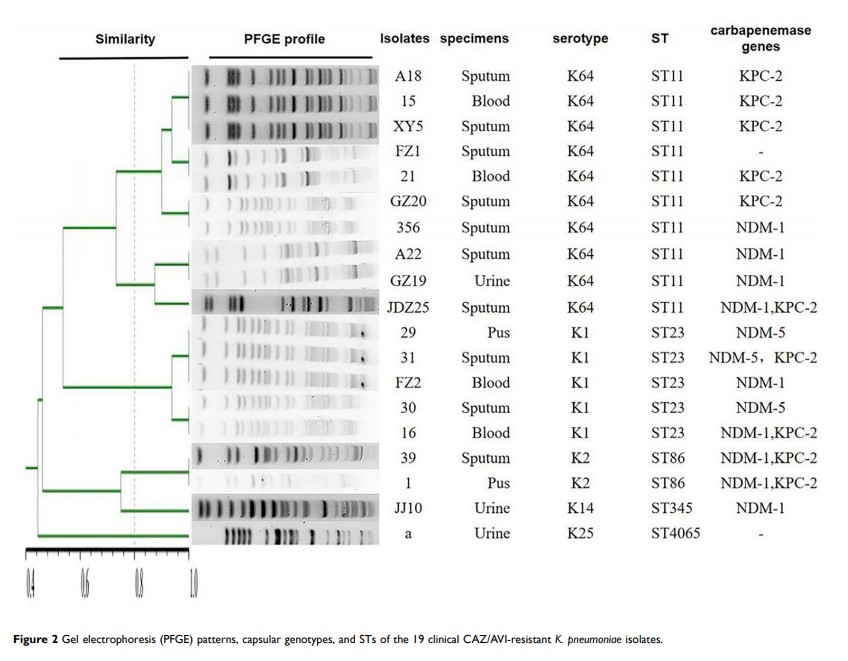9 7 7 6 7
论文已发表
注册即可获取德孚的最新动态
IF 收录期刊
- 3.3 Breast Cancer (Dove Med Press)
- 3.4 Clin Epidemiol
- 2.5 Cancer Manag Res
- 2.9 Infect Drug Resist
- 3.5 Clin Interv Aging
- 4.7 Drug Des Dev Ther
- 2.7 Int J Chronic Obstr
- 6.6 Int J Nanomed
- 2.5 Int J Women's Health
- 2.5 Neuropsych Dis Treat
- 2.7 OncoTargets Ther
- 2.0 Patient Prefer Adher
- 2.3 Ther Clin Risk Manag
- 2.5 J Pain Res
- 2.8 Diabet Metab Synd Ob
- 2.8 Psychol Res Behav Ma
- 3.0 Nat Sci Sleep
- 1.8 Pharmgenomics Pers Med
- 2.7 Risk Manag Healthc Policy
- 4.2 J Inflamm Res
- 2.1 Int J Gen Med
- 4.2 J Hepatocell Carcinoma
- 3.7 J Asthma Allergy
- 1.9 Clin Cosmet Investig Dermatol
- 2.7 J Multidiscip Healthc

一家中国三级医院出现高毒力、头孢他啶/阿维巴坦耐药的肺炎克雷伯菌分离株
Authors Li D, Liao W, Huang H, Du F, Wei D, Mei Y, Long D, Wan L, Liu Y, Zhang W
Received 8 April 2020
Accepted for publication 16 July 2020
Published 3 August 2020 Volume 2020:13 Pages 2673—2680
DOI https://doi.org/10.2147/IDR.S257477
Checked for plagiarism Yes
Review by Single anonymous peer review
Peer reviewer comments 3
Editor who approved publication: Professor Suresh Antony
Introduction: Carbapenem-resistant hypervirulent Klebsiella pneumoniae (CR-hvKP) is increasingly reported worldwide, but ceftazidime/avibactam (CAZ/AVI)-resistant hvKP isolates have rarely been observed. We attempted to characterize them in clinical CRKP isolates collected from a university hospital in China from March 2016 to March 2018.
Methods: All isolates were analyzed by antimicrobial susceptibility testing, molecular detection of antibiotic resistance determinants, multilocus sequence typing (MLST), SDS-PAGE, and pulsed-field gel electrophoresis (PFGE). The pLVPK-related genetic loci (rmpA2, terW, iutA, and silS ) were screened in all CAZ/AVI-resistant CRKP isolates for the presence of virulence plasmids by PCR. Capsule typing, serum killing assay, Galleria mellonella lethality experiments, and mouse lethality assay were conducted to identify CAZ/AVI-resistant hvKP among isolates that carried all four virulence genes.
Results: A total of 232 CRKP isolates were collected. Overall, CAZ/AVI-resistance was found in 8.2% (19/232) CRKP isolates isolated from patients with no history of previous CAZ/AVI-based treatment. Among these, 63.2% (12/19) were metallo-β-lactamase-producing K. pneumoniae (MBL-KP), 52.6% (10/19) were Klebsiella pneumoniae carbapenemase (KPC)-producing K. pneumoniae (KPC-KP), and 26.3% (5/19) produced both MBL and KPC. The presence of carbapenemase promoted a very high increase in CAZ/AVI minimum inhibitory concentration only when ompk35 and ompk36 were absent. Alarmingly, nine isolates had all four virulence genes for the presence of virulence plasmids. All nine isolates were considered to be CAZ/AVI-resistant hvKP according to the G. mellonella infection model and mouse lethality assay, with ST23 being the most common type (55.6%, 5/9).
Conclusion: The newly emerged hypervirulent CAZ/AVI-resistant KP strain might cause a serious threat to public health, suggesting an urgent need for enhanced clinical awareness and epidemiologic surveillance.
Keywords: ceftazidime/avibactam-resistant, hypervirulent, Klebsiella pneumoniae , ompk35
